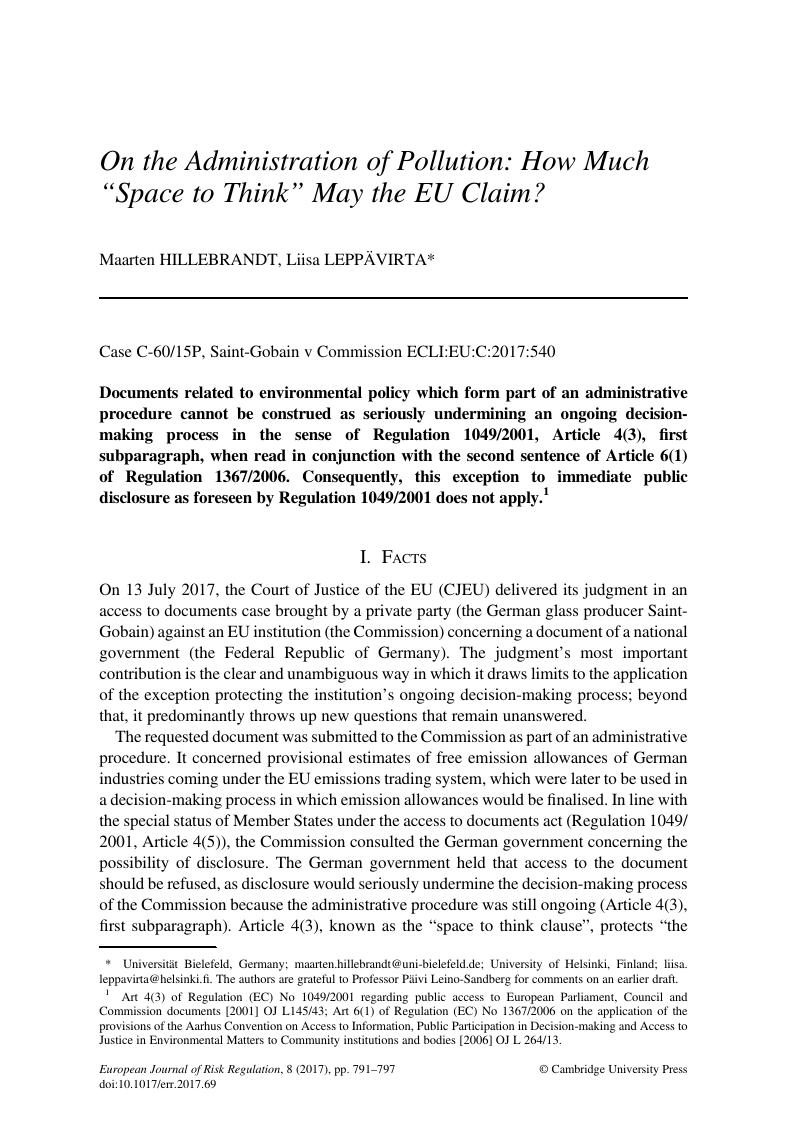No CrossRef data available.
Article contents
On the Administration of Pollution: How Much “Space to Think” May the EU Claim?
Published online by Cambridge University Press: 06 December 2017
Abstract

- Type
- Case Commentaries
- Information
- European Journal of Risk Regulation , Volume 8 , Special Issue 4: Special Issue on the EU Public-Health-Security Nexus , December 2017 , pp. 791 - 797
- Copyright
- © Cambridge University Press
Footnotes
Universität Bielefeld, Germany; maarten.hillebrandt@uni-bielefeld.de; University of Helsinki, Finland; liisa.leppavirta@helsinki.fi. The authors are grateful to Professor Päivi Leino-Sandberg for comments on an earlier draft.
Art 4(3) of Regulation (EC) No 1049/2001 regarding public access to European Parliament, Council and Commission documents [2001] OJ L145/43; Art 6(1) of Regulation (EC) No 1367/2006 on the application of the provisions of the Aarhus Convention on Access to Information, Public Participation in Decision-making and Access to Justice in Environmental Matters to Community institutions and bodies [2006] OJ L 264/13.
References
2 Case T-476/12, Saint-Gobain Glass Deutschland v Commission ECLI:EU:T:2014:1059, paras 64–65.
3 Opinion of Advocate General Szpunar, paras 77–78.
4 Case C-60/15P, Saint-Gobain v Commission ECLI:EU:C:2017:540, paras 75–76.
5 ibid, para 79.
6 ibid para 81.
7 ibid paras 82–83.
8 See cases cited in nn 13 and 14, also Case T-59/09, Germany v Commission ECLI:EU:T:2012:75.
9 See above, Section II.
10 Cf Smith, M, “Developing Administrative Principles in the EU: A Foundational Model of Legitimacy?” (2012) 18(2) ELJ 269, 274 CrossRefGoogle Scholar.
11 See also Declaration 35 of the Treaty of Amsterdam amending the Treaty on European Union, the Treaties establishing the European Communities and certain related acts [1997] OJ C 340/1. Before Regulation 1049/2001, applicants of documents originating from Member States were advised to redirect their request.
12 Heremans, T, “Public access to documents: Jurisprudence between principle and practice (Between jurisprudence and recast)” (2011) Egmont Paper 50, 75 Google Scholar.
13 Case C-64/05, Sweden v Commission (IFAW I) ECLI:EU:C:2007:802, para 58 and Case C-135/11 P IFAW Internationaler Tierschutz-Fonds v Commission (IFAW II) ECLI:EU:C:2012:376, para 57.
14 Even though the case law seems settled on this question, it is far from unambiguous. For a recent judgment summarising the relevant case law, see Case T-344/15 France v Commission ECLI:EU:T:2017:250, paras 50–58.
15 Supra, note 4, para 87; supra, note 3, para 93.
16 Cases where the applicants have been unsuccessful in their argumentation include, but are not limited to: Case T-214/11 ClientEarth and PAN Europe v EFSA ECLI:EU:T:2013:483; Case T-245/11 ClientEarth and International Chemical Secretariat v ECHA ECLI:EU:T:2015:675 and Case T-402/12 Schlyter v Commission ECLI:EU:T:2015:209.
17 On the contrary, in the context of infringement procedures, the CJEU interpreted Art 6(1) of Regulation 1367/2006 in a way that removed infringement procedures from its scope entirely and accepted a general presumption for their non-disclosure. See in particular Case C-514/11 LPN and Finland v Commission ECLI:EU:C:2013:738, para 84. Similarly, the GC established a general presumption protecting documents drawn up in the context of preparing an impact assessment regardless of the fact that Art 6(1) was invoked: Joined Cases T-424/14 and T-425/14 ClientEarth v Commission ECLI:EU:T:2015:848. An appeal on the case is pending. The case is discussed below.
18 In a judgment concerning a draft assessment report issued by the Federal Republic of Germany, as rapporteur Member State for the active substance glyphosate, the CJEU was asked to interpret the concept of “emissions into the environment” in Art 6(1) and it specifically denied narrow interpretation of the concept: Case C-673/13 P Commission v Stichting Greenpeace Nederland and PAN Europe ECLI:EU:C:2016:889, paras 51–55, 70.
19 Compare supra, note 4, para 86 and supra, note 3, para 78.
20 Supra, note 4, paras 78–82 and supra, note 3, para 78.
21 Supra, note 4, para 81 and supra, note 3, para 76.
22 Supra, note 4, para 82. See also Regulation 1049/2001, Art 4(3), first subparagraph, which speaks of “… a document […] which relates to a matter where a decision has not been taken…”. For a general account of the policy cycle model, see Young, AR, “The European Policy Process in Comparative Perspective” in H Wallace, MA Pollack and A Young (eds), Policy-Making in the European Union, 7th edn (Oxford University Press, 2015) 47–49 Google Scholar.
23 Supra, note 4, para 83. Regulation 1049/2001, Art 4(3), first subparagraph, speaks of disclosures that would “seriously undermine the institution’s decision-making process”, while the environment-specific provision in Aarhus Convention, Article 4(4)(a), speaks of disclosures that would adversely affect “the confidentiality of the proceedings of public authorities”.
24 See above, Section II.
25 Supra, note 12, 279.
26 Supra, note 4, para 85.
27 Leppävirta, L and Darbishire, H, “The right to ask … the right to know – the successes and failures in access to documents rules and practices from an NGO perspective” in C Harlow, P Leino and G della Cananea (eds), Research Handbook on EU Administrative Law (Edward Elgar, 2016) 413–415 Google Scholar.
28 Joined Cases T-424/14 and T-425/14 ClientEarth v Commission ECLI:EU:T:2015:848, paras 103–106. An appeal on the case is pending.




